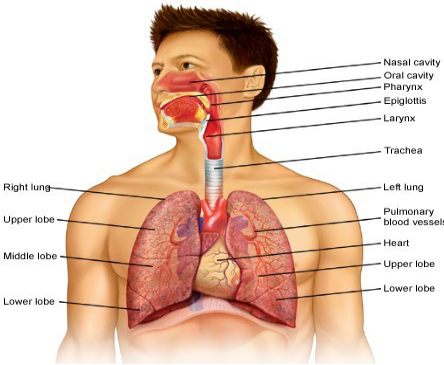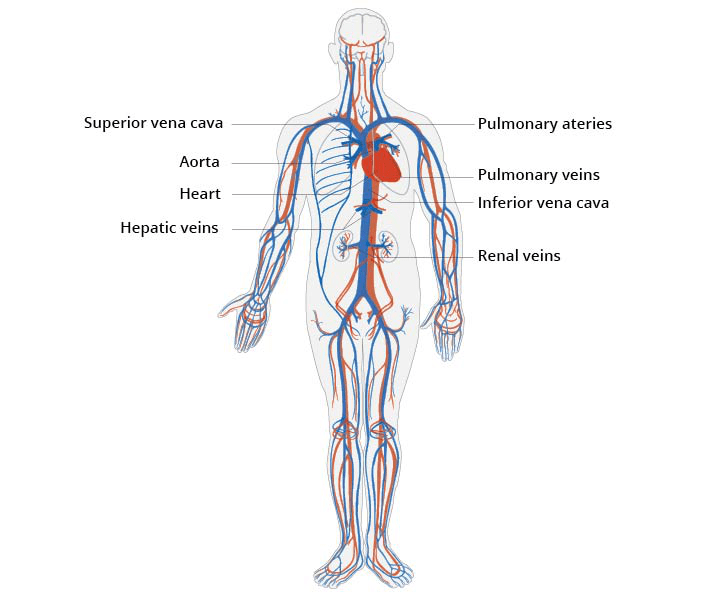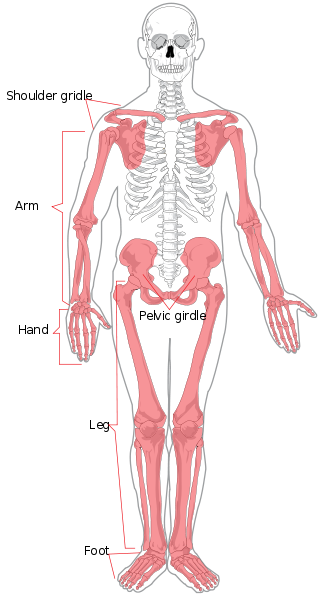INTRODUCTION
The human body has a complex structure and a combination of various organ systems, cells and tissues. In this regard, physiology refers to the study of each structure's functions. In the health and care field, this concept is based on physiological principles where services are provided to people to give them relief from specific issues (Sarafino and Smith, 2014). In this regard, an assignment is prepared to make a critical analysis of physiological principles for health and social care. It describes the structure and function of the human body and the relationship between various functions on the basis of anatomy and physiology study. Further, a description of the way data is collected in health and social care. In addition to this, the present report also highlighted how the age of an individual affects the structure and function of the body.
TASK 1
1.1 Anatomical Features of the Human Body
Anatomy is a biological study which describes the subdivision of human body parts, animals and other living organisms. It is considered as a study which helps in analysing body structure from the front and back. It is a combination of various forms of cells which aid in creating tissues and their organ's instrumentation. Anatomy is a complex scientific method that deals with diverse systems as follows endocrine, nervous, reproductive etc. Human structure is a working of separate parts like the head, neck, upper limbs, bone, abdomen etc. Construction of the living body depends on cardiovascular, nervous, urinary, respiratory, reproductive processing etc. For example: The digestive system, which plays a vital role in the human body because converting food into nutrients, vitamins and minerals is a hard task. Intake of food provides energy and the ability to stay alive. The working of this system depends on the mouth, stomach, large intestine, small intestine, throat etc. The human body constitutes a number of biological system which performs specific functions for everyday living (Eyles and Woods, 2014). It includes the circulatory system whose main function is to move nutrients, oxygen, blood, carbon-di-oxide and others all over the body. This part consists heart, blood vessels, arteries and veins. Similarly, the digestive system is another main part of the body which involves a series of connected organs that absorb food by breaking it down into small particles as well as remove excreta as well. Therefore, anatomical features of the body can be described in the following manner:-

We Promise Exceptional Assignment Writing & No AI Shortcuts !
View Samples Order Now Assignment helpNervous system: The body part consists of various organs and they are interrelated with each other. Any action of body parts is allowed by the nervous system. It is complex in nature, as total organs depend on signals provided by nerves. Some cells are directly connected with the brain, then it passes to the spinal cord and to other parts of the body. This system is made up of two combinations central and peripheral. Central control is done by the brain and spinal cord. Somatic and autonomic come under the peripheral part of the nervous system. It controls voluntary actions like conscious movement and involuntary actions such as breathing. Thus, through this process, it sends signals to different organs of the body. In addition to this, the nervous system has two major subdivisions which are: Autonomic (Involuntary actions) and Somatic (Voluntary actions). In this regard, the somatic nervous system includes nerves which connect the spinal cord and brain with sensory receptors in the skin and muscles. While the autonomic regulates specific processes of the body. It includes breathing rate, blood pressure and more.

Respiratory system: It refers to a biological system which consists of specific organs and structures used for oxygen exchange living body. In terms of response to physical activities under the mentioned case scenario includes- pulse and respiratory rate, breathing or oxygen transport and more, are increased. Thus, when the transportation of oxygen in the body increases the rate of respiratory will also be enhanced (Gardner, Pearce and Mitchell, 2017). In this regard, when a person of young age does physical exercise for long hours the strength of respiratory muscles, oxygen diffusion rate and vital capacity of the body will increase.

Cardiovascular system: This system relates to the heart organ which helps in blood circulation, and transportation of nutrients like electrolytes, amino acids and more. It can also be defined as a system which consists of main parts of the body like the heart, blood vessels, veins arteries etc. Thus, in response to physical activities by the college-going student, this system releases neurotransmitters. In addition to this, pulse rate, stroke volume of the heart and blood pressure increase at a high rate. Furthermore, during physical activities, the heart transmits blood to those areas of the body where the demand for oxygen is greater. All these responses increase heat, therefore, in this case, the body will start sweating. The main function of this system in the body is to pump blood in all parts. It contains blood vessels which carry essential things like oxygen and other nutrients, to help for growth. Thus, in this regard, the body takes such essential nutrients from blood as well as dumps waste such as carbon dioxide and other excreta as well. Moreover, the major role of the cardiovascular system in the living body is to maintain blood flow therefore, it allows it to survive as well. Some parts of this system like veins, are used to deliver blood from other parts, back to the heart. Thus, it is considered that blood in veins intakes low oxygen because it is taken out by the body. Similarly, it is rich in carbon dioxide as the bodies of living beings unload it back into blood. As shown in the figure below the right atrium used to pump blood into the right ventricle. Further, this ventricle sends blood to the pulmonary trunk and then from veins to the lungs. Thus, under this process, in the lungs, blood picks up air or oxygen by breathing and exhaling carbon dioxide.

Musculoskeletal system: This is an organ system which consists of cardiac, skeletal and smooth muscles that respond in various manners. It maintains postures, allows movement, and circulates blood throughout the body as well. Thus, in order to respond to daily routine work, this system includes different types of contradictions. It includes eccentric, concentric and isometric contractions which are developed when body muscles contract during physical work. Moreover, the response under the skeletal system under present cases, reveals that with an increase in synovial fluid, the movement of different joints of the body will enhance. In addition to this, the ligaments of that individual gain strength and the density of bones also increases in such cases. Smooth muscles of this system help in controlling the flow of substances within the lumens of hollow organs. While skeletal and cardiac muscles consist of striations which are only visible under the microscope because of minute components within cells. These subdivisions of the musculoskeletal system allow the body to move.

1.2 The Way the System of Body Interacts with Functions for Growth
Role of cellular METABOLISM in growth:- The body depends on functioning of cells, this operation of cells in the body which helps action to carry out is termed as metabolism. Processing of body parts depends on chemical activeness as they provide energy. Reactions depend on an all those living organism and cells like digestive, nervous, respiratory etc. BMR(basal metabolic rate calculated in kilojoules(KJ) This rating assists the body the systems are working correctly or not. If rates are getting higher then the surface area of the body like weight, and height gets impacted.
Role of growth hormone in body growth:- Intergrowth of the body depends on cells as they cover very sensitive parts of the body like bone, muscle and hair growth. Bones develop very frequently with growing tissues. Suffering in tumours, cells which have positive behaviour turn into negative or divide signals an into uncontrolled system of the body. When tissues get an increase in obesity hypertrophy i.e. cells size gained. Due to genetic nature or individual eating capacity are signs of being obese (Harriss, MacSween and Atkinson, 2017). Replacement of tissue for hair, and skin acts as a barrier that helps in preventing from harmful microorganisms and components. Substitution of tissues prevents injuries.
Stuck with your Assignment?
Hire our PROFESSIONAL ASSIGNMENT WRITERS and
Get 100% Original Document on any Topic to Secure A+ Grade
TASK 2
2.1 Response of Body During Regular Activities
As per the given case, it is evaluated that an individual under the age group 25 years, is generally engaged in a lot of physical activities. It includes: studying continuously for long hours, keeping the mind and other parts of the body active etc. Therefore, under such cases, normal body response in various ways as explained below:
The body of a human generally maintains a state of equilibrium which is also called homoeostasis. Here, an individual has no feelings in terms of sickness, uneasiness or other unpleasant signs. Therefore, in order to study continuously for long hours, the body of a person manages a range of complex functions. Therefore, it entails the probable change with respect to physiological and psychological functions. It includes breathing, eating, excretion and coordination with others. In this regard, the liver is responsible for maintaining fat and carbohydrate metabolism. While, the excretory system reabsorbs essential materials like iron, salt levels in the blood, regulated pH levels and excreted waste from the body. A normal person of a young age can do all such activities related to physical and psychology without any hazards. But for this process, they need healthy food to eat at regular intervals of time. This would help in keeping the mind and other systems of the body activated so that the body will respond normally.
2.2 Explanation of Body Response in Terms of Physiology, Cellular and Tissue Structure
Integrated responses of the body in accordance with tissue and cellular structure can be better explained in the following manner:- When an individual carries out various activities on a regular basis the need for oxygen in the skeletal muscles increases. In this regard, tissues become able to burn extra fat and a level of sugar in the body (Parahoo, 2014). Thus, this would make muscles more strong in an individual. Furthermore, to meet the oxygen demand of various organs and tissues the distribution of flow of blood also changes. So, it entails that such a person is required to consume healthy and nutritious food as well as avoid spicy or junk eatables. But in context with college going person or individual of 25 age-group, conduct studies for long working hours so it influences respiration process of body. Under this case, rate of respiration rate will increase, where the body requires more fresh air for the inhaling process in order to respond in a deep manner. In addition to this, working for more than 7 to 8 hours continuously by a person increases stress levels also. Under this process, the body becomes tired and it requires energy drinks to keep the mind refreshed and activated.
2.3 The Way Body Coordinates with its Internal Activities
Homoeostasis refers to maintaining the optimum internal environment of a body, under which various organs function on a continuous basis. It can also defined as a tendency for maintaining stable conditions in internal environment and make adjustments to the body according to the external atmosphere. Therefore, due to the mechanism of homoeostasis, the temperature of the body is kept within the normal range as well and nutrients are supplied to cells as needed. Moreover, kidneys are used to maintain homoeostasis within the body by regulating the adequate amounts of salt and excreting water. For example: In order to conduct studies on a continued basis for more than 6 hours, the nervous system of the body plays an important role. In this context, the main tissues which are responsible for internal coordination within the body are the endocrine and nervous systems. The way of coordination in this regard can be explained in the following manner:-
In the human body, a response takes place when receptors of a cell receive a stimulus. Through cell conductors, these responses are then transferred to effectors. Therefore, in this respect, the body of individuals response to adapt to changes. Since there is no single system which coordinates the overall functions of the body, so, the nervous system controls and maintains functions through central, autonomic and peripheral. Under this process, the central nervous system controls the functions of the mind and body as it consists spinal cord. Here, the brain interprets the external environment as per situations and controls the movement of the body (Oliver, Foot and Humphries, 2014). Therefore, it is also known as the centre of processing sensory information. While the spinal cord acts as a communication bridge between the brain and other sensory receptors. Thus, in this regard, all functions of a body will coordinate with other functions with the help of the nervous system. This will eventually keep the mind and other sensory organs of a person active during the study as well as respond to the outside environment.
TASK 3
3.1 Explanation of Recording and Use of Routine Measures in Health and Social Care
Record of routine measures refers to the main process of developing a health and social care plan for an individual. It provides data on a person who is suffering from a health-related issue and integrates further for patient care. The purpose behind taking records of sick people in terms of pulse and respiration rate, blood pressure, intake of food etc. By this process, service providers can determine which type of treatment needs to be given to a certain person. In addition to this, patients will also become able to access their own health records as well as examine medicines prescribed to them, current diagnoses and schedules of appointments (Sheldon and et. al., 2014). According to the given case study, a person aged 65 years, suffers from hypertension which develops chest pain. Therefore, the way to record the mentioned states and their uses in health and social care can be explained in the following manner:-
Temperature: This part of the body depicts a vital sign, which is required to measure accurately. The temperature of a normal person is 98.6 degrees Fahrenheit, which states that any decrease or increase, reveals a certain cause. It is generally measured by a thermometer. But as per innovation and high technological advancements, temperature can also recorded by the thermometer which consists of a wide range (Manotas and et. al., 2014). It includes mercury, bimetallic and digital thermometers. By measuring temperature, service providers can ascertain the stage of illness and determine the type of treatment needed for further improvement. As per the given scenario, the person is suffering from hypertension therefore, temperature refers to a routine measure.
Pulse rate: It defines a number of times, the heart rate of a person pumps for executing blood circulation and respiratory system. For a healthy and normal person, pulse rate is 60 to 100 beats per minute. Therefore, as per the present scenario, the adult person suffers from chest pain and hypertension. So, it is necessary for service providers to measure the pulse rate of such a person from time to time.
Blood pressure: It is important to measure the blood pressure of an individual because high BP creates more risk of health problems in the patient's arteries and heart. In this kind of situation, people may suffer from headaches or dizziness but in some cases, they don't feel any different changes in their body. Normal blood pressure level is between 135/85 and 140/90 mm Hg. Some factors which influence the BP of an individual are stress, cold temperature, smoking, caffeine or alcoholic consumption, weight gain or loss etc. In the present case, the BP of adult age persons having chest pain to high-stress levels, due to intake of heavy food, stressful environment or another thing, might increase or decrease in a regular manner (Fredriksen-Goldsen and et. al., 2014). Therefore, by taking a record of BP in regular manner, service providers can diagnose which factor affects health and increase blood pressure. Through this process, they can prescribe better medicines and suggestions for such patients.
Electrocardiography (ECG): It is a systematic process of recording heart-related activities by using electrodes. These flat metal electrodes are attached to the patient's chest to detect electrical charges generated by the heart beat it shown by the graph. It is a non-invasive test that diagnoses the heart system and its disease. Throughout this cardiologists get a better understanding by knowing heart rate and estimating cardiac efficiency. Service providers consider this process for knowing about cardiac diseases such as chest pain, shortness of breath, fainting spells, weakness and control of it.
Body mass index:- Taking records about the BMI of an individual is major concern in health and social care. Information provided from this measurement process generally does not calculate accurately therefore, only approximated value is taken (Davis Boykins, 2014). Body mass test is only done for measuring weight i.e. weight or underweight from a normal weighted person. To calculate BMI there are some parameters as 18.5 considered as underweight, 18.5 to 24.9 as a healthy person, 25 to 29.9 as overweight and above all these values obesity take place, but these factors depend on individual height and age. In context with old age people who are suffering from chest pain and hypertension, body mass index will help service providers in determining treatment procedures for resolving such issues.
3.2 Assess the Way of Providing Information About Body Functioning by Routine Measures
Under this, necessary information is given through routine measures in the case of 65 years 65-year-old person. The Temp., Pulse, BP, BMI, ECG etc. are Haemodynamic Monitoring of the Human Body. These are all effective tools for measuring the body from various perspectives. In addition to this, Body Mass Index will signify how much an individual is overweight and the measures which can minimize his weight. More than 30, BMI indicates that an individual is overweight. In addition to this, body temperature will signify whether a person is suffering from a fever or not. On the basis of body temperature, the fever of an individual can be measured. The temperature of a normal person is between 97.8 to 99.1 degrees. But in the case of a fever, the body temperature of a person crosses 100 degrees (Tilley and Cameron, 2014). When the average person endures such a level of beats twice then the possibility of Brain strokes and heart attack rises by 70%. If an individual, has a high fever then their pulse rate will be high and they will not be able to perform in a good manner. Under this, the measurement of blood pressure will state the probability of an individual developing the high blood pressure. If an individual is obese, then the chances of Blood pressure will be enhanced. For a normal person, Blood pressure is less than 120/80 which means over 80 and below 120 can be moved away possibility of any heart-related disease or stroke. If the blood- pressure of a person is above 115/75 mmHg, then the probability of rising cardiovascular enhanced. With the help of an Aneroid monitor, Finger- wrist and digital monitor, Blood Pressure (BP) can be measured. On the other hand, ECG is related to the heart and it helps with the signs of heart-related disease. It gives information about heart rate and also rhythm. When the rhythm of a person is regular then the heart rate is 300 divided through a number of the larger squares among QRS complexes. On the other hand, the second method is to use with irregular rhythm in order to estimate the rate. In this, count a number of the R waves in a 6-second strip and then multiply by 10.
3.3 Information About the Body's Functioning may Inform Care Planning for This Person
Through information about the functioning of the body, care homes can be planned for concerned people. Care and special attention can be provided towards treating organs of the body which are not properly functioning (Hussain and et. al., 2015). Enhanced BMI can be brought with in normal range by giving him the basic treatment that will include proper nutrition as well as a diet plan. In context to this, physical activities are also necessary for that person. Under this, there can be the adoption of a better approach to the long- term weight management. Symptoms of Flu and Fever are ascertained through body temperature and it will be helpful in providing the necessary treatment 65 years old man which can help to recover him. In this regard, service providers of health and social care are used to assume Hemo-dynamic states (King and et. al., 2015). It includes body temperature, blood pressure respiration rate etc. Since people are accustomed to high stress and depression stages, then in such cases homoeostasis level of the body much affected. Therefore, under this condition, the body temperature of such people becomes more high.
Similarly, the BP of adult age-group people is normally considered as 120 or 80 beats per second. But in context with the person who suffers from hypertension then in this case, BP will critically fluctuate. High stress and chest pain sometimes lead to either brain or heart stroke. In addition to this, the respiration rate of such patients also increases as per stress level. Henceforth, all such information assists service providers of health and social care, to determine treatment of sick people accordingly.
TASK 4
4.1 Age May Affect Body Structure and Functioning
All vital organs start to lose some of their functions as age at the time of adulthood. In this, ageing modifications can occur in tissues, organs and cells of bodies which impact on functioning of the body system. This 85-year-old lady has Type 2 Diabetes and also suffers from arthritis in her knees. With increasing age, the spinal cord and brain both have lost weight and nerve cells. Under this age, may have impacted on muscles that help in breathing. So, she would not be able to exhale and inhale air (Bowen and Murshid, 2016). In context to this, age may impact integumentary systems like cells can become irregular and larger. It can have thinner skin, is prone to injuries and is translucent. The age of 85 years lady can have effect on the functioning and structure of her body related to the respiratory and nervous systems mentioned below:
Nervous system- The functions of the brain vary with the age of the central nervous system. Under this, several tend to learn verbal abilities, intellectual performance and material tend which come from experience and wisdom. By ageing reaction of 85 years old lady, will be minimised in the past. Her Spinal Cord began to weaken and this body part controls requires proper time for reaction in regard to the bodily environment. On the other hand, the Peripheral Nervous System will show less voluntary effort and impulses. If blood circulation goes down, neurotransmission and Synapse become higher, fewer reflexes and lower sensation can be noticed in the behaviour of 85 years 85-year-old lady.
Respiratory system- Ageing impact on respiratory activities exhaling and inhaling is the same as to impact of ageing in the other organs. Under this, gas exchange and inhaling become slower, respiratory reflexes become weaker. In addition to this, sometimes Influenza, Pneumococcal infections and many others may happen to a person.
4.2 Impact of Common Disorders on Body Structure and Functioning
Cells are developing the blocks of tissues and all the cells experience modification with ageing. In old age, they become less able and also larger to multiply and divide. At the age of 85, several cells loss the ability to function and they start to function abnormally (Taggart and Cousins, 2014). The impact of high BP may play a necessary role in cognitive and dementia decline over time. Reduced flow of blood impacts the brain and causes thinking as well as memory issues. When the pressure at which blood travels gets enhanced then it starts to damage the artery walls and will affect body structure. In case of fever, it directs the defences towards the infection place. A rise in the body temperature assesses a person to resolve any infection. But if the temperature is high then it can lead to complications and can be serious. In this, the body of a person will not be able to do proper functioning. On the other hand, its impact on the body structure is that high temperature leads to induces shivering, enhances metabolism rate, body moves blood to the warmer interior etc.
Under this, there are many common disorders for instance absence of mind, impaired or loss of function of tissues, organs such as ataxia, incontinence etc. At the age of 85, she is suffering from Type 2 Diabetes which can cause Foot complications, Ketones, DKA, Nephropathy, Gastroparesis and Stroke. In context to this, arthritis is a disease of joints and it causes stiffness, hips, joints, shoulder etc. At the age of 85 years, the body stops functioning and can not work properly (Daskalakis and Yehuda, 2014). Arthritis can occur in older people due to the result of the long years of tear and wear on the body. It can arise from past injuries and normal physical activity. Of their bad health, that 85-year lady is not able to function in a healthy manner and after some time she has a wound on her leg and from this, she is unable to walk.
4.3 Relation Between Effects of Common Disorders and Infection to Care Routinely Given to Individuals Affected
As per the present case, apart from diabetes, the medical condition of the old lady is well-related to medical care. Due to age factors and arthritis, service providers of health and social care cannot recommend to such patients to do any physical exercise. It includes regular walks in the morning and evening, which is the most essential part of treatment for diabetic patients. Thus, it would affect routine care treatment for mentioned old lady. In this regard, to give relief from arthritis pain, service providers will recommend painkillers, as there were no more solutions for this. Similarly, for giving treatment to recover wounds on the leg, which is not healing well, caretakers will keep dressing in a regular manner (Sturmberg and et. al., 2017). They will regularly check wounds and change dressing in order to reduce the development of bacteria on wounds. It also helps in preventing patients from worms which may occur due to late recovery. In this regard, necrosis or dead cells and excess tissue generally occurs with diabetic injuries and wounds. This would promote bacteria which may create infections. So, it is essential for caretakers to remove dead tissue as well.
CONCLUSION
It has been concluded from this assignment that physiology refers to a study of the function of body parts and how they respond to physical activities by a person. Similarly, anatomy in this regard, helps in evaluating the relationship between different parts of the body. Further, physiological principles in health and social care, state procedures taken by service providers for care planning of an individual who is suffering from a certain type of health issues. It describes in what manner, care planners diagnose disease of persons and set medical planning for further treatment.
Get online Anatomy Assignment Help from subject experts at the Assignment Desk and improve your grades beyond imagination. Submit your Anatomy assignment work on time and impress your mentors.
REFERENCES
- Sarafino, E. P. and Smith, T. W., 2014. Health psychology: Biopsychosocial interactions. John Wiley & Sons.
- Eyles, J. and Woods, K. J., 2014. The Social Geography of Medicine and Health (RLE Social & Cultural Geography). Routledge.
- Gardner, F. P., Pearce, R. B. and Mitchell, R. L., 2017. Physiology of crop plants (No. Ed. 2). Scientific Publishers.
- Harriss, D. J., MacSween, A. and Atkinson, G., 2017. Standards for ethics in sport and exercise science research: 2018 update. International journal of sports medicine. 38(14). pp.1126-1131.
- Parahoo, K., 2014. Nursing research: principles, process and issues. Macmillan International Higher Education.
- Oliver, D., Foot, C. and Humphries, R., 2014. Making our health and care systems fit for an ageing population. King's Fund.
- Sheldon, S.H., and et. al., 2014. Principles and Practice of Pediatric Sleep Medicine E-Book. Elsevier Health Sciences.
- Fredriksen-Goldsen, K. I., and et. al., 2014. The health equity promotion model: Reconceptualization of lesbian, gay, bisexual, and transgender (LGBT) health disparities. American Journal of Orthopsychiatry. 84(6). p.653.
- Davis Boykins, A., 2014. Core communication competencies in patient-centered care. ABNF Journal. 25(2).
- World Health Organization and World Health Organization. Management of Substance Abuse Unit, 2014. Global status report on alcohol and health, 2014. World Health Organization.
- Tilley, L. and Cameron, T., 2014. Introducing the index of care: A web-based application supporting archaeological research into health-related care. International Journal of Paleopathology. 6. pp.5-9.
- King, T .L., and et. al., 2015. Varney's midwifery (p. 3). Burlington, MA: Jones & Bartlett Learning.
- Bowen, E. A. and Murshid, N. S., 2016. Trauma-informed social policy: A conceptual framework for policy analysis and advocacy. American journal of public health. 106(2). pp.223-229.
- Taggart, L. and Cousins, W., 2014. Health promotion for people with intellectual and developmental disabilities. McGraw-Hill Education (UK).
- Daskalakis, N. P. and Yehuda, R., 2014. Principles for developing animal models of military PTSD. European journal of psycho traumatology. 5(1). p.23825.
- Sturmberg, J. P., and et. al., 2017. ‘Multimorbidity'as the manifestation of network disturbances. Journal of Evaluation in Clinical Practice. 23(1). pp.199-208.
- Manotas, M., and et. al., 2014. Association of brief mindfulness training with reductions in perceived stress and distress in Colombian health care professionals. International Journal of Stress Management. 21(2). p.207.
- Hussain, A., and et. al., 2015. Health and emergency-care platform for the elderly and disabled people in the Smart City. Journal of Systems and Software. 110. pp.253-263.
- Online
- The Effects of Hypertension on the Body, 2018. [Online]. Available through: <https://www.healthline.com/health/high-blood-pressure-hypertension/effect-on-body#8>.


 Company
Company













